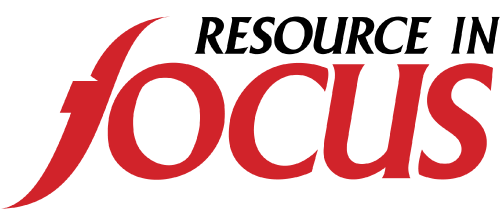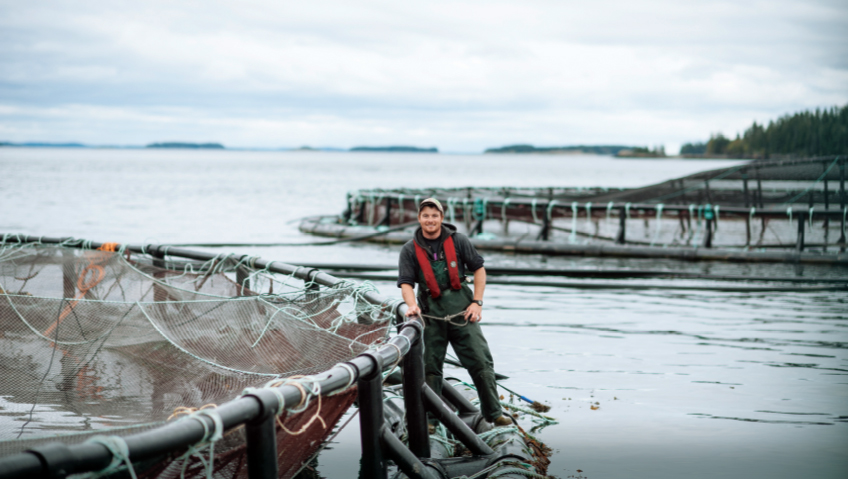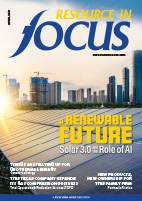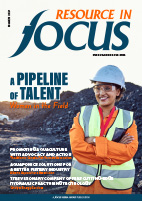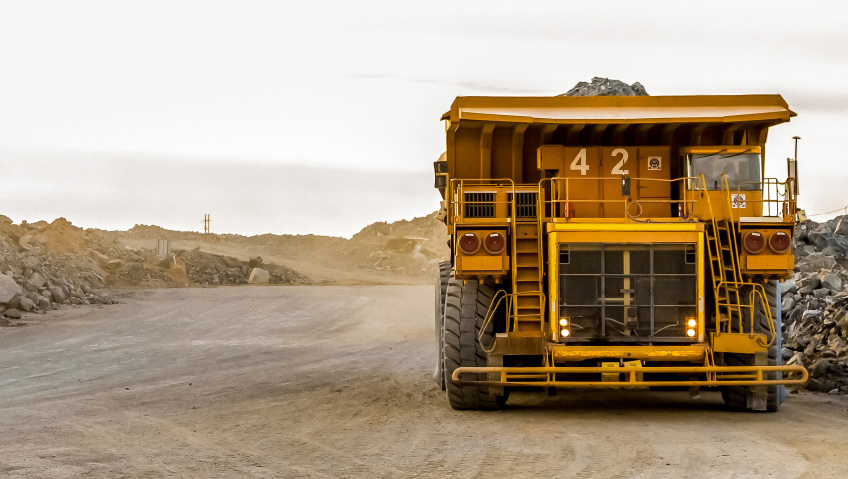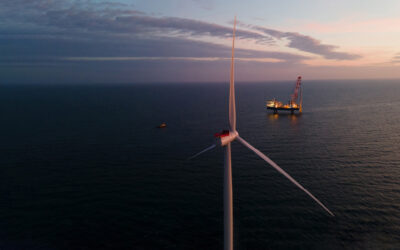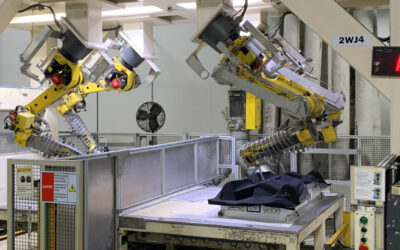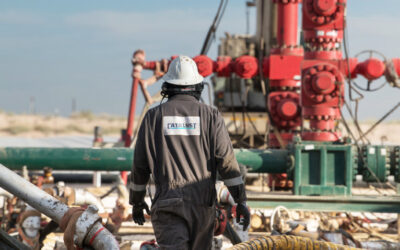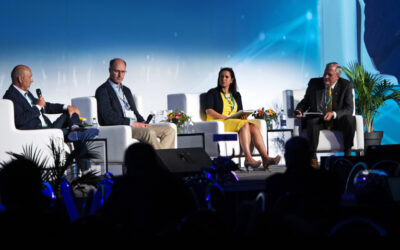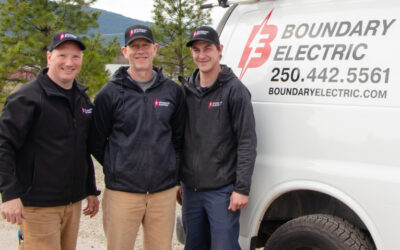Atlantic Canada’s salmon farming sector employs 8,000 people, generates $2 billion in annual revenue, and provides over 320 million meals a year—an important consideration given how COVID-19 has interrupted international food supply chains and highlighted the value of locally grown healthy food. While fish farming—also called aquaculture—might seem like a foreign concept to many, the process is relatively straightforward.
“I tell people that salmon aquaculture is simply a third party certified process of rearing fish from egg to plate,” explains Sue Farquharson, Executive Director of the Atlantic Canada Fish Farmers Association (ACFFA), based in Letang, New Brunswick.
The ACFFA represents the finfish sector, “and the majority of that right now is salmon in Atlantic Canada,” she continues.
Step one in salmon farming involves gathering eggs from salmon broodstock. Young fish are then reared in freshwater hatcheries on land for twelve to eighteen months. When ready, the fish are moved to netted cages moored to the ocean floor. Salmon spend another eighteen to twenty-four months in these saltwater environs while being carefully monitored. Specially designed nets keep salmon inside the cages and predators out.
Most Atlantic Canada salmon pens are roughly eight to fourteen metres deep with a circumference anywhere between 70 and 150 metres, according to the ACFFA, and a fish farm in Atlantic Canada typically uses several of these cage systems. Salmon occupy less than five percent of the cage, giving them plenty of room to move about. These operations produce 40,000 to 70,000 tonnes of fish each year, accounting for half of all farmed salmon in Canada.
The ACFFA’s role is to provide “a consistent, strong, positive voice on behalf of the salmon farming industry,” Farquharson explains. “That includes advocating for a responsible, effective regulatory framework and educating people in general about salmon farming. We’re really proud of the work that we do,” she says.
An industry-funded group, the ACFFA currently has over eighty members including feed producers, food service companies, fish farmers, and traditional fishermen. “We have lobster fishermen here. We have clam fishermen here. We all work together,” states Farquharson.
The association also operates a marine facility called Limekiln Wharf Service Centre in Letang for its members and has done extensive research and development work. As for public education, the ACFFA strives to highlight the benefits of salmon aquaculture and the strict conditions under which the industry operates.
“Each salmon farm is selected on a number of science-based criteria that includes hydrology, water temperatures, and depths. It’s all science-based. We’re a heavily regulated industry. There’s over seventy pieces of regulation that manage this particular industry, and that includes a lot of environmental policies and codes of practise we have to adhere to both federally and provincially,” she notes.
Even though salmon aquaculture produces less waste than people believe, fish farms— like farms on dry land—are fallowed regularly. Farmed salmon are usually given vitamin-rich dry pellets to eat that consist of natural plant, fish, and animal proteins. Growth hormones are not part of the mix, and antibiotic use is limited.
Fish pens are typically situated in coastal areas where strong currents and tides provide flushing action, removing excess waste. Underwater cameras and sensors monitor operations and divers perform additional, in-person inspections. Farms are also closely monitored by provincial and federal regulators.
The ACFFA tries to counteract the common misconception that salmon aquaculture caused the decline in wild Atlantic salmon stocks. “The decline of wild Atlantic salmon has been happening since the mid to late 1800s, and it’s well-documented. The federal government established the first hatcheries for stocking purposes for just that reason,” says Farquharson.
She says that fish farms balance sustainability with the increasing popularity of seafood. “I think they’re tied to one another. Sustainability and the growing demand for seafood equals the need for salmon aquaculture. [Salmon aquaculture is] responsible, it’s sustainable, and it’s innovative.” Compared to other types of food production, fish farms have “a small environmental footprint,” she adds. “Jacques Cousteau knew 50 years ago that we had to start farming our oceans to be sustainable.”
The message seems to be getting through; a poll released in June 2020 found over eighty percent of people in Atlantic Canada supported the aquaculture industry. Survey respondents agreed that “local salmon farming is a reliable and sustainable source of protein,” noted an ACFFA press release.
Like all other Canadian food producers, the Atlantic salmon aquaculture sector had to deal with the impact of the COVID virus. Keeping people safe was priority number one, says Farquharson.
“Aquaculture was designated as an essential service right away here in Atlantic Canada. There’s no doubt it took a hit like other food producers, but we’ve seen significant rebound and uptick in the last six months,” she says.
The pandemic shuttered businesses and played havoc on international trade, including food supply chains. As such, the COVID crisis is a timely reminder about “the importance of having an industry like this and locally produced food in your backyard,” she says.
COVID has had an impact in other ways. In the fall of 2020, to protect the health of participants, the ACFFA hosted an online-only version of its annual aquaculture research conference. One of the largest conferences of its kind, this two-day event features experts and attendees from around the world that present on industry trends, technology, and research projects.
The virtual conference was “well-received. We had two hundred attendees, and we charged them a minimal fee. We always make a donation to a charitable organization and last year we made a donation of $3800 to the Charlotte County Cancer Society,” she reports.
The ACFFA plans to put on a hybrid conference this year featuring both online and in-person activities. While the final conference format remains up in the air, pending pandemic restrictions, “One way or the other, we will definitely have our two-day forum,” vows Farquharson.
The ACFFA regularly collaborates with other fishing organizations, government officials and Non-Government Organizations (NGOs). The ACFFA belongs to a stakeholder group for the Bay of Fundy and a committee that works to reduce marine debris, for example.
“We work with First Nations and other partners, and we collaborate a lot with my provincial colleagues that are multi-species associations here in Atlantic Canada as well as our national affiliate, the Canadian Aquaculture Industry Alliance,” she explains.
‘Multi-species’ refers to associations that work with a variety of aquaculture species, not just finfish, like ACFFA.
The ACFFA is also heavily involved in aquaculture research and development, with an emphasis on “salmon conservation and wild salmon interaction,” Farquharson says.
She cites a wild salmon conservation project as one of the most significant of these research and development initiatives. The conservation project is a huge effort involving “industry, the federal government, provincial governments, First Nations, Parks Canada, and academia… operating the world’s first marine wild salmon conservation farm. It’s a fantastic project that we’re pretty proud of.”
The ACFFA traces its roots to 1987 and an organization called the New Brunswick Salmon Growers’ Association (NBSGA). Over the years, the organization grew, changed its name, and expanded its advocacy reach to cover the Atlantic Provinces of New Brunswick, Prince Edward Island, Nova Scotia, and Newfoundland and Labrador. Regardless of its name, the association has always been based in Letang and has always been dedicated to salmon aquaculture.
While the association’s focus has remained the same, the industry itself has changed over the decades.
In the organization’s early days, it was made of “multiple small farmers, many were traditional fishers that converted their weirs to try salmon farming. They had never done it before; it was brand new. Today our association represents fewer farmers. On the other hand, we represent more of the service industry that has grown with the industry. As the number of farm owners has become lower, the service industry has expanded. The aquaculture industry now supports over 1,300 various companies throughout the Atlantic Region,” she states.
Not counting COVID, the biggest challenge facing the Atlantic salmon aquaculture industry is maintaining a sustainable workforce. “We need a trained workforce to help the industry continue to develop and thrive. We operate in rural, coastal communities which already have lower populations, and not everyone wants to live and work in rural coastal locations,” she explains.
The ACFFA has teamed up with the New Brunswick Community College (NBCC) to establish a program to educate people about various facets of the aquaculture industry. The aim is to drum up interest in the field and retain employees. These efforts have been complemented by advertisements and other ACFFA promotional activities highlighting aquaculture and the opportunities it provides for the Atlantic region.
Going forward, the ACFFA plans to continue its focus on salmon aquaculture. During planning sessions, the group pondered whether to expand its scope, possibly to other species. In the end, association officials decided against such a move, keeping with what it does best.
“We’ve already been here for thirty-plus years. We’re an industry-funded association, and we work solely on behalf of salmon farmers. So, we’ll be here doing what they want us to do [into the future], and that’s been outlined in our 2020 strategic plan. Really, in a nutshell, we provide a strong, positive, regional voice on behalf of the salmon farming industry,” states Farquharson.
